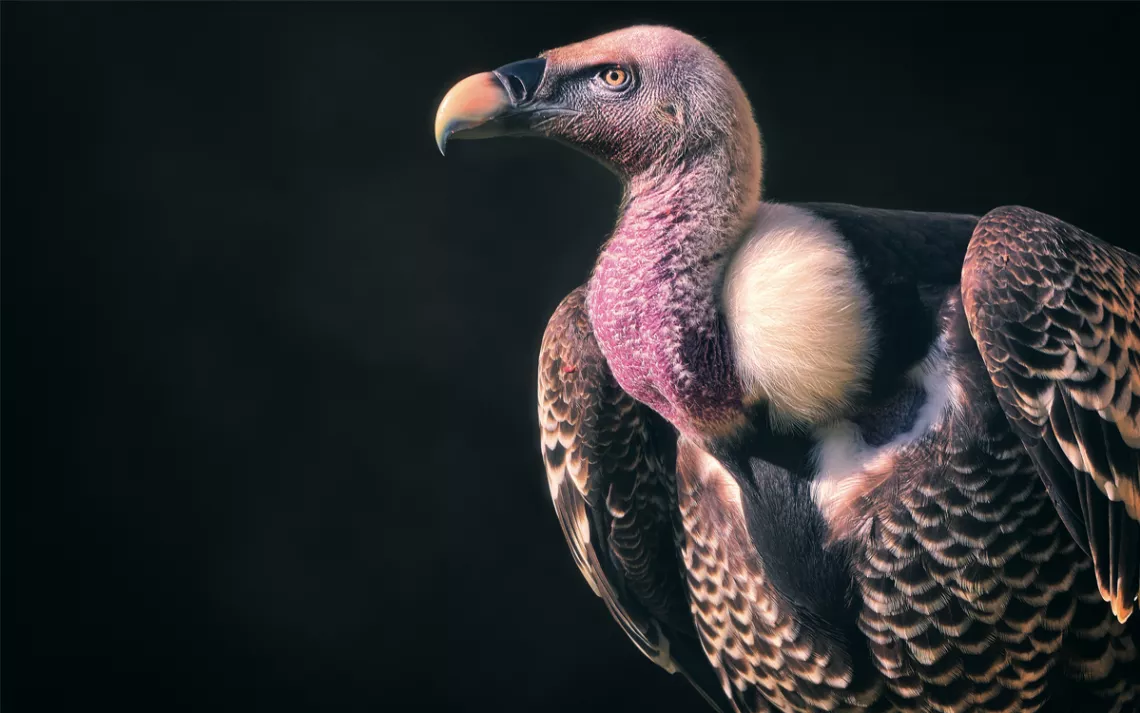Rüppell's Vultures: Not Pretty, But They Get the Job Done
You don't miss scavengers until no one's around to eat the carrion

Photo by Darren Song Ng
Circling African skies, the Rüppell's vulture stands out for its size, wingspan, and high-flying abilities. In 1973, a commercial jet flying at 37,000 feet over Abidjan, Ivory Coast, collided with one and had to make an emergency landing. The birds haven't been recorded at such heights since, leading experts to conclude that the vulture may have been sucked into the plane's airstream at a lower altitude. But they do regularly cruise the troposphere at an impressive 7,300 feet. Gyps rueppelli's ability to soar higher than most species comes thanks to a genetic adaptation in their hemoglobin that allows them to function despite low pressure and a lack of oxygen. Immature birds (those not yet breeding) have been known to fly thousands of miles across the African continent in search of food, as their unrivaled eyesight allows them to see carrion from high in the sky.
Rüppell's vultures' enormous range—and the fact that they'll do just about anything to avoid human interaction—make them difficult to track. Ornithologist Darcy Ogada is the assistant director of Africa programs at the Peregrine Fund and has spent the past three decades studying Rüppell's vultures in Kenya. She says that the birds are notoriously tough to keep tabs on because they make their nests on cliff faces that can be reached only by helicopter. "You definitely do not want to get one in your chopper blades," she says, "because it will not be pretty."
Beyond buzzing the vultures' nests with helicopters, humans have relentlessly tormented them in other ways. Rüppell's vultures are regularly killed for their heads, talons, and feathers, which are made into charms—thought to allow people to see into the future. They're also the victims of poachers who poison the carcasses of rhinoceroses and elephants (to kill off vultures whose circling might alert authorities to the crime). In 2020, 2,000 endangered hooded vultures in Guinea-Bissau died after consuming chunks of meat laced with the pesticide methiocarb. And vultures of all varieties are accidentally killed by herders who set out poison meant for predators like hyenas and lions.
Rüppell's vultures reproduce slowly, even under the best of circumstances: Adult birds feed their fledglings in the nest for more than a year, and females reproduce only every other year.
As a result, these efficient scavengers have been pushed to the brink of extinction. According to the International Union for Conservation of Nature, Rüppell's vultures' numbers have decreased to just 22,000, and they are listed as critically endangered.
This is a shame, because vultures do nature's dirty work with grace, and the circle of life would be incomplete without them. Their enormous beaks are perfectly adapted to break down carcasses, and they prevent the spread of disease because bacteria and viruses can't survive their highly acidic digestive systems. Without these birds, many diseases would run rampant. Rüppell's vultures don't need us (other than to leave them alone), but we most certainly need them.
This article appeared in the Spring 2022 quarterly edition with the headline "Cleanup Crew."
Did You Know?
The Rüppell's vulture doesn't start breeding until age five; it produces one avocado-size egg at a time.
These birds have a wingspan of eight feet and a life span of 40 to 50 years.
 The Magazine of The Sierra Club
The Magazine of The Sierra Club



